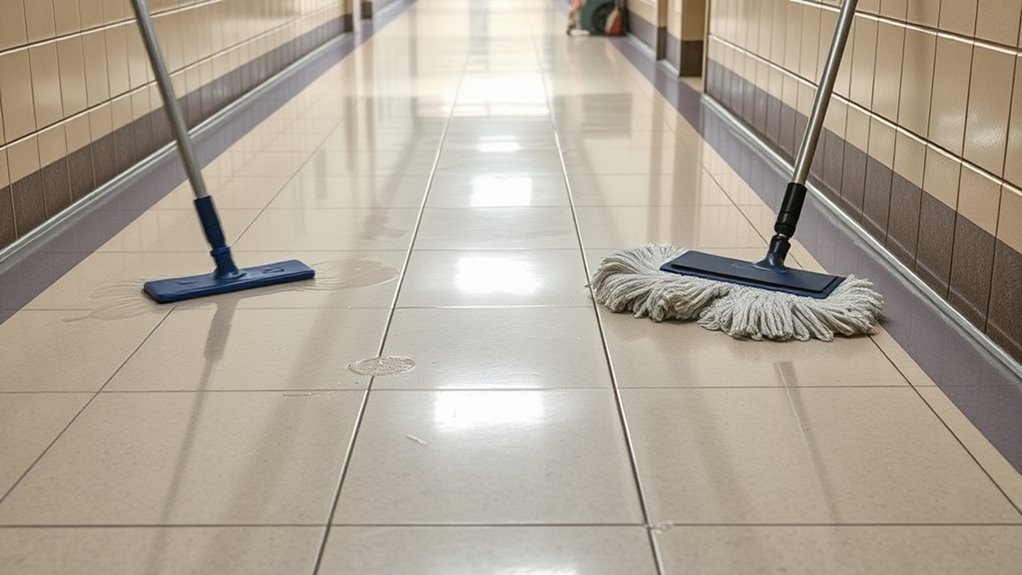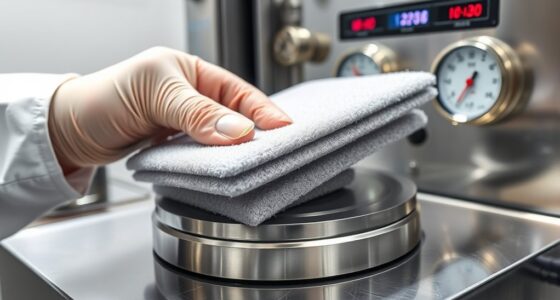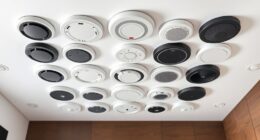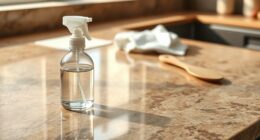One common mistake is not following clear cleaning protocols, which leads to skipping vital steps or using improper techniques, leaving floors dirty or sticky. Poor equipment maintenance, like neglecting inspections or ignoring worn brushes, causes breakdowns and uneven cleaning. Rushing through tasks or using malfunctioning scrubbers reduces efficiency and may damage surfaces. Addressing residue buildup and ensuring proper use of cleaning solutions can make a significant difference. Keep these tips in mind to improve hallway cleanliness and avoid costly repairs over time.
Key Takeaways
- Follow detailed cleaning protocols to prevent missed steps and ensure thorough hallway sanitation.
- Regularly inspect and maintain scrubbers to avoid breakdowns and ensure effective cleaning performance.
- Use appropriate cleaning solutions and correct scrubber settings for different flooring types.
- Allow sufficient dwell time for cleaning solutions and rinse thoroughly to prevent residue buildup.
- Schedule routine deep cleaning and equipment maintenance to avoid wear and ensure consistent results.

Have you ever noticed how school hallways are often left sticky or dirty despite regular cleaning efforts? It’s frustrating because it suggests something isn’t working quite right. One common issue stems from the way scrubbers are used or maintained, which often ties back to inconsistent cleaning protocols and poorly managed maintenance schedules. When these protocols aren’t clear or followed properly, it’s easy to miss spots or use the wrong techniques, leading to the buildup of grime and sticky residues that are tough to remove.
Inconsistent protocols and poor maintenance cause sticky, dirty school hallways despite cleaning efforts.
A key mistake is neglecting to establish or stick to a detailed cleaning protocol. Without specific instructions on how and when to clean, staff might skip crucial steps or use improper methods. For example, some might rely solely on mops rather than scrubbers for heavily soiled areas. This can leave behind dirt or sticky residues that aren’t effectively removed, especially if the scrubber isn’t used correctly. Proper cleaning protocols should specify the type of cleaning agents, the frequency of deep cleaning, and the correct scrubber settings or techniques to ensure thorough results. When these aren’t in place or ignored, the cleaning process becomes inefficient, and hallways remain visibly unclean.
Maintenance schedules are equally vital but often overlooked. If your school doesn’t regularly inspect and service scrubbers—checking for worn brushes, clogged nozzles, or malfunctioning parts—you risk equipment breaking down during critical cleaning times. This results in incomplete cleaning and persistent messes. A well-planned maintenance schedule helps catch issues early, ensuring scrubbers operate at peak performance. Failing to do so means using equipment that’s not functioning properly, which can scratch floors, spread dirt, or leave residues. Regularly scheduled maintenance keeps equipment in top shape, preventing common errors like uneven scrubbing or missed spots. Additionally, understanding the importance of equipment longevity can help schools prioritize timely repairs and replacements.
Another mistake is rushing through the process without allowing enough dwell time for cleaning solutions to work. Many underestimate how long a solution needs to sit before scrubbing or rinsing. Not following this step results in stubborn stains and sticky patches that are hard to remove with quick passes. Additionally, using the wrong cleaning solution for specific flooring types can cause residues that attract dirt, making hallways appear dirtier over time.
Frequently Asked Questions
How Often Should Hallways Be Scrubbed for Optimal Cleanliness?
You should scrub hallways at least once a week to maintain ideal cleanliness and hallway hygiene. Implementing a consistent cleaning schedule ensures dirt, germs, and debris are regularly removed, preventing buildup and promoting a healthier environment. Depending on foot traffic and usage, you might need to clean more frequently, especially during flu season or after special events. Maintaining a reliable cleaning routine keeps hallways safe, clean, and inviting for everyone.
What Cleaning Products Are Safest for School Hallways?
Did you know eco-friendly sanitizers and non-toxic cleaning agents are your safest options for school hallways? You should choose products with natural ingredients that minimize harmful chemicals, ensuring a healthier environment for students and staff. Look for labels indicating eco-friendliness and non-toxicity, and always follow manufacturer instructions. These choices not only protect everyone’s health but also promote a sustainable cleaning routine that benefits your entire school community.
Are There Specific Scrubber Models Recommended for School Environments?
You should consider school scrubber models like the Tennant T7 or Nilfisk SC500 for hallway cleaning. These hallway cleaning equipment options are reliable, durable, and designed for high-traffic areas. Look for models with adjustable brushes, easy maneuverability, and safety features. Investing in the right school scrubber models guarantees efficient cleaning, reduces time spent, and maintains a clean, safe environment for students and staff alike.
How to Train Staff Effectively on Proper Hallway Cleaning Techniques?
Think of training your staff like planting seeds for a lush garden. You’ll want to develop clear training protocols that break down proper hallway cleaning techniques step-by-step. Engage your staff through hands-on demonstrations and regular feedback to keep them motivated. Encourage questions and discussions to boost staff engagement. Consistent reinforcement and positive reinforcement help turn good habits into second nature, ensuring hallways stay spotless and safe.
What Are the Signs Indicating a Scrubber Needs Maintenance or Replacement?
You’ll notice a scrubber needs maintenance or replacement when it shows machine malfunction signs like strange noises, error messages, or power issues. Inconsistent cleaning results, such as streaks or missed spots, also suggest it’s time for a check-up. If these problems persist despite basic troubleshooting, it’s best to replace the machine or schedule professional repairs to ensure efficient and thorough hallway cleaning.
Conclusion
Now that you’re aware of these common scrubber mistakes, you can avoid them and keep your hallways cleaner and safer. Think of your cleaning routine like a well-choreographed dance—each step matters. By making small adjustments, such as checking your equipment and following proper techniques, you’ll prevent costly errors and create a healthier environment for everyone. Remember, a little attention to detail goes a long way—like sunshine breaking through clouds, your efforts brighten the school day.








